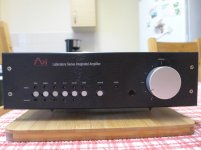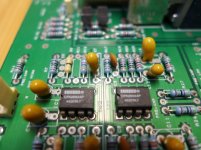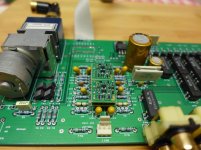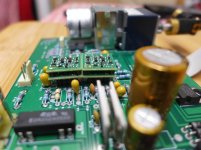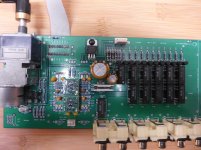hi all
just wanted to give a mention and thumbs up regarding my positive experience replacing some standard op amps for some sparko discrete op amps in the preamp amp section of my avi labs integrated amplifier.
the sparko SS3602 dual op amp replacements have really taken this amplifier to a whole new level i feel.
i've been playing it now for two days solid since i've done this mod and i'm still in amazement at the transformation that these sparko discrete op amps have brought to this great old amplifier.
it now sounds in a totally different league compared to the original regarding musicality,detail,soundstaging,air and presence,without upsetting the original amps charm or abilities.
it sounds leaner and brighter after this mod but you soon realise that this is due to the smear and waffle being taken out of the bass,you now pick out hidden details in a bass line that you never noticed before,bass lines stop and start instantly and if anyone is familiar with this avi amp sound then you know how great these amps do bass to start with.
and at last we have tones and textures thrown in there to,this is what i was hoping for as i felt this was one of the biggest failings with the sound of this amplifier in standard form.
the treble is so extended ,smooth and detailed with plenty of air,i really cant believe the amount of extra detail that is coming through,its exactly the same story for the midrange to,its all unforced and natural sounding and i think thats is the best way of describing what these discrete op amps have done for this amp,its just made this amp so much more musical while offering up more realism and detail,dynamics and contrasts but in a natural unforced way,the speakers seem to have disappeared all together as the soundstaging is well and truly massive,constraints and boundaries seemed to have disappeared,the avi in its standard form had a bit of a upfront nature to its presentation,i really liked that,this mod has changed that presentation slightly,it now has a deeper soundstage depth and the original forwardness isn't as aggressive,but its not so laid back as to become boring or soft,a nice balance has been struck here.
of course this is just all one man's opinion and views but i've been so impressed with this product,not to mention the service and speedy delievery that i thought i would give them a mention in case others are thinking of giving them a try.
by the way and to make clear...i have no connection,vested interest or anything to gain regarding promoting and praising this product,im just one very happy customer that's really impressed with this product and wanted to share my experience using it.
regards
just wanted to give a mention and thumbs up regarding my positive experience replacing some standard op amps for some sparko discrete op amps in the preamp amp section of my avi labs integrated amplifier.
the sparko SS3602 dual op amp replacements have really taken this amplifier to a whole new level i feel.
i've been playing it now for two days solid since i've done this mod and i'm still in amazement at the transformation that these sparko discrete op amps have brought to this great old amplifier.
it now sounds in a totally different league compared to the original regarding musicality,detail,soundstaging,air and presence,without upsetting the original amps charm or abilities.
it sounds leaner and brighter after this mod but you soon realise that this is due to the smear and waffle being taken out of the bass,you now pick out hidden details in a bass line that you never noticed before,bass lines stop and start instantly and if anyone is familiar with this avi amp sound then you know how great these amps do bass to start with.
and at last we have tones and textures thrown in there to,this is what i was hoping for as i felt this was one of the biggest failings with the sound of this amplifier in standard form.
the treble is so extended ,smooth and detailed with plenty of air,i really cant believe the amount of extra detail that is coming through,its exactly the same story for the midrange to,its all unforced and natural sounding and i think thats is the best way of describing what these discrete op amps have done for this amp,its just made this amp so much more musical while offering up more realism and detail,dynamics and contrasts but in a natural unforced way,the speakers seem to have disappeared all together as the soundstaging is well and truly massive,constraints and boundaries seemed to have disappeared,the avi in its standard form had a bit of a upfront nature to its presentation,i really liked that,this mod has changed that presentation slightly,it now has a deeper soundstage depth and the original forwardness isn't as aggressive,but its not so laid back as to become boring or soft,a nice balance has been struck here.
of course this is just all one man's opinion and views but i've been so impressed with this product,not to mention the service and speedy delievery that i thought i would give them a mention in case others are thinking of giving them a try.
by the way and to make clear...i have no connection,vested interest or anything to gain regarding promoting and praising this product,im just one very happy customer that's really impressed with this product and wanted to share my experience using it.
regards
Attachments
Last edited:
What a lucky break, that IC1 and IC2 on the original board were spaced apart by just the right amount to allow two sparkos PCBs with no overlap and no air gap.
Another lucky break, that the yellow tantalum bypass capacitors were spaced far away from the ICs. Any closer and they would have collided (picture #4).
Since your ears are telling you that the sparkos opamps sound different than the Burr Brown opamps, why not investigate whether the sparkos opamps sound different than each other? The PCB silkscreen indicates that the left opamp handles "tape" and the right opamp handles "pre-amp". I imagine you want to make sure that the best possible sound comes from the "pre-amp" part of the equipment, even at the cost of not quite as good sound from the "tape" part of the equipment. So: why not swap the two sparkos opamps and give it a listen? Choose whichever configuration that sounds the best to your ears, using the input and output selections which are most important to you.
Your next step might be to experiment with the power supplies. A simple and minimally-invasive tweak is to add a new loading resistor to each supply (from V+regulated to ground, and from V-regulated to ground), to increase the standing current in each voltage regulator circuit. Higher current means higher gm of the output pass transistor, which means lower output impedance, which means better transient response. Costs less than $1 and takes less than an hour, what's not to like?
Another lucky break, that the yellow tantalum bypass capacitors were spaced far away from the ICs. Any closer and they would have collided (picture #4).
Since your ears are telling you that the sparkos opamps sound different than the Burr Brown opamps, why not investigate whether the sparkos opamps sound different than each other? The PCB silkscreen indicates that the left opamp handles "tape" and the right opamp handles "pre-amp". I imagine you want to make sure that the best possible sound comes from the "pre-amp" part of the equipment, even at the cost of not quite as good sound from the "tape" part of the equipment. So: why not swap the two sparkos opamps and give it a listen? Choose whichever configuration that sounds the best to your ears, using the input and output selections which are most important to you.
Your next step might be to experiment with the power supplies. A simple and minimally-invasive tweak is to add a new loading resistor to each supply (from V+regulated to ground, and from V-regulated to ground), to increase the standing current in each voltage regulator circuit. Higher current means higher gm of the output pass transistor, which means lower output impedance, which means better transient response. Costs less than $1 and takes less than an hour, what's not to like?
From a quick look at the resistors around the opamp, I speculate that there are 10R resistors in series with each supply pin to each opamp. The voltage regs for the +/-15V supplies look to be off the PCB entirely (there's a connector top centre for power). Sonic improvements likely come from much reduced supply line noise due to the Sparkos's operating in classA. I would definitely suggest lowering the value of the 10R resistors (assuming they do indeed sit in series with the supplies) to something closer to 2R2.
if it is Jfet input vs bipolar on a phono stage you will hear an improvement. I converted a single stage HA1457 phono pre to a 2 stage. The improvement is incredible, Tight bass and slightly more top end treble then a CD. I was going to replace the old chip but really there is no need to.
OPA2604 is already an excellent op amp.
OPA2604 is already an excellent op amp.
Sparko's Lab SS3602
Rolling Op-amps in Gustard H20 Headphone Amplifier
Rolling Op-amps in Gustard H20 Headphone Amplifier | Audio Science Review (ASR) Forum
Rolling Op-amps in Gustard H20 Headphone Amplifier
Rolling Op-amps in Gustard H20 Headphone Amplifier | Audio Science Review (ASR) Forum
Everything is surface-mounted so not replaceable other than the pair that are socketed. You can see that I swapped one of the channels to Sparko's Lab SS3602 from TI/National LME 49720:



I note the Sparko's have 4.5uA of bias current, which is going to be an issue in some circuits with DC bias voltage. And of course the current-noise will be a lot higher than a 5532/4 as a result, but the distortion looks decent.
Hideously expensive for the performance, given the LM4562 is now pretty cheap.
Hideously expensive for the performance, given the LM4562 is now pretty cheap.
I think BillShurv kind of stuck the donkey with a tail. But then, when people put expensive mods in their equipment, it is astounding how many of them report magical transformations following! With a part that delivers –130 dB harmonic distortion levels across the board, compared to that which is being replaced doing about the same, I am pretty sure that any-and-all magnificent “improvements” wouldn't survive A-B-X testing. But I'm just still sad that DF96 passed. Someone has to hold up the buggy-whip!
...I am pretty sure that any-and-all magnificent “improvements” wouldn't survive A-B-X testing.
I may well be missing something but I can't figure out why this would be important. Suppose by some heroic persuasion skills you get a much-maligned audiophile to carry out an ABX test and he fails it, scoring random. Then what? Seems to me he goes back to normal sighted listening and the differences which disappeared under (artificial) controlled conditions reappear. Everyone's happy
I may well be missing something but I can't figure out why this would be important. Suppose by some heroic persuasion skills you get a much-maligned audiophile to carry out an ABX test and he fails it, scoring random. Then what? Seems to me he goes back to normal sighted listening and the differences which disappeared under (artificial) controlled conditions reappear. Everyone's happy
Yeah ... one important fact. Perceived differences that fail in AB tests then re-appear in normal use are most often Imaginary and all you've accomplished is wasting money on something that ultimately makes no difference at all.
Yeah … one important fact. Perceived differences that fail in AB tests then re-appear in normal use are most often Imaginary and all you've accomplished is wasting money on something that ultimately makes no difference at all.
I personally am going to give Abraxo “the nod” on this. His was a humorous finalé: at least someone is interested enough in the insides of their rather remarkable amplifier to take a chance and substitute a part in that “ought to work”, pin for pin. Let's not try to justify whether the expense is justified. Made him/her happy.
⋅-⋅-⋅ Just gently saying, ⋅-⋅-⋅
⋅-=≡ GoatGuy ✓ ≡=-⋅
I personally am going to give Abraxo “the nod” on this. His was a humorous finalé: at least someone is interested enough in the insides of their rather remarkable amplifier to take a chance and substitute a part in that “ought to work”, pin for pin. Let's not try to justify whether the expense is justified. Made him/her happy.
At $79.00 a pop ... no, it's snake oil and it's a rip off.
That $160 could have gone to taking the better half out for a surprise date, which I'm sure would have accomplished a lot more than wasting it on those opamps.
Yeah ... one important fact. Perceived differences that fail in AB tests then re-appear in normal use are most often Imaginary and all you've accomplished is wasting money on something that ultimately makes no difference at all.
Is there any evidence for this claimed 'fact' ? I recently read a scientific paper about placebo effect in evaluating hearing aids. Test subjects were divided into two groups - one group was given a standard hearing aid and the other group were given a 'digitally enhanced' hearing aid. But apart from the colours of the cases, they were identical innards. Those who had the 'digitally enhanced' aids scored higher on (objective) hearing tests. How would this be possible if, as you claim the differences are 'imaginary' ?
they were identical innards. Those who had the 'digitally enhanced' aids scored higher on (objective) hearing tests. How would this be possible if, as you claim the differences are 'imaginary' ?
In the same way that people get better when given sugar pills instead of their prescriptions ... If you've read about the placebo effect you know that people can convince themselves of anything. But, unfortunately the benefits of self-deception rarely last.
Seriously... what is the point of spending $160 on two exotic op-amps when we know in advance they're not going to make any real difference.
In the same way that people get better when given sugar pills instead of their prescriptions ...
Yep, except in your view they didn't get better, they only imagined themselves better.
If you've read about the placebo effect you know that people can convince themselves of anything. But, unfortunately the benefits of self-deception rarely last.
Yours appear to be doing rather well.
Seriously... what is the point of spending $160 on two exotic op-amps when we know in advance they're not going to make any real difference.
But those who buy them do not in fact 'know' that.
So no answer to my original question about evidence that perceived changes are often 'imaginary'? I take it then that you have none, nada, zilch in support of your alleged 'fact'.
So no answer to my original question about evidence that perceived changes are often 'imaginary'? I take it then that you have none, nada, zilch in support of your alleged 'fact'.
Sure tons of proof... it's called proper training and test equipment. It's plain science... if you can't isolate the exact difference then it most likely isn't real.
Take any amplifier, put in the exotic caps, swap outputs, tamper with the bias, whatever you want to do... If it still measures the same after all that, the only difference you've made is to your friend's bank account and the warranty on his amp.
So why don't you tell me in reasonable detail exactly what difference these 3rd party $79.00 parts actually make in a circuit?
- Status
- This old topic is closed. If you want to reopen this topic, contact a moderator using the "Report Post" button.
- Home
- Amplifiers
- Solid State
- sparko discrete op amps
